2013 Peugeot 508 Hybrid warning
[x] Cancel search: warningPage 67 of 340

2
65
Access
Low fuel level
When the low fuel level in the
tank is reached, this warning lamp comes on in the instrument panel, accompanied by an audible warning and a message in the instrument panel screen.
When it first comes on, around 7 litres of fuel
r
emain in the tank.
You must refuel as soon as possible to avoid
runnin
g out.
Fuel supply cut-off
Your vehicle is equipped with a safety device
which cuts off the fuel supply in the event of a collision.
It is still possible to use a fuel can to fill
the tank but this must be done slowly. In order to ensure a good flow of fuel, do not place the nozzle of the fuel can in direct contact with the flap of themisfuel prevention device.
Diesel misfuel prevention
Mechanical device which prevents filling the tank of a Diesel vehicle with petrol. It avoids the risk of
engine damage that can result from filling with the wrong fuel.
Located in the filler neck, the misfuel prevention device appears when the filler cap is removed.
When a petrol
filler nozzle is introduced into the fuel filler neck of your Diesel vehicle, it comesinto contact with the flap. The system remains
closed and prevents filling. Do not persist but introduce a Diesel filler
nozzle.
Operation
Tr a v e l l i ng abroad
As Diesel fuel pump nozzles may be different
in other countries, the presence of the misfuel
prevention device may make refuellingimpossible.
Before travelling abroad, we recommend that you check with the PEUGEOT dealer network,
whether your vehicle is suitable for the fuel
pumps in the country in which you want
to travel.
Page 73 of 340
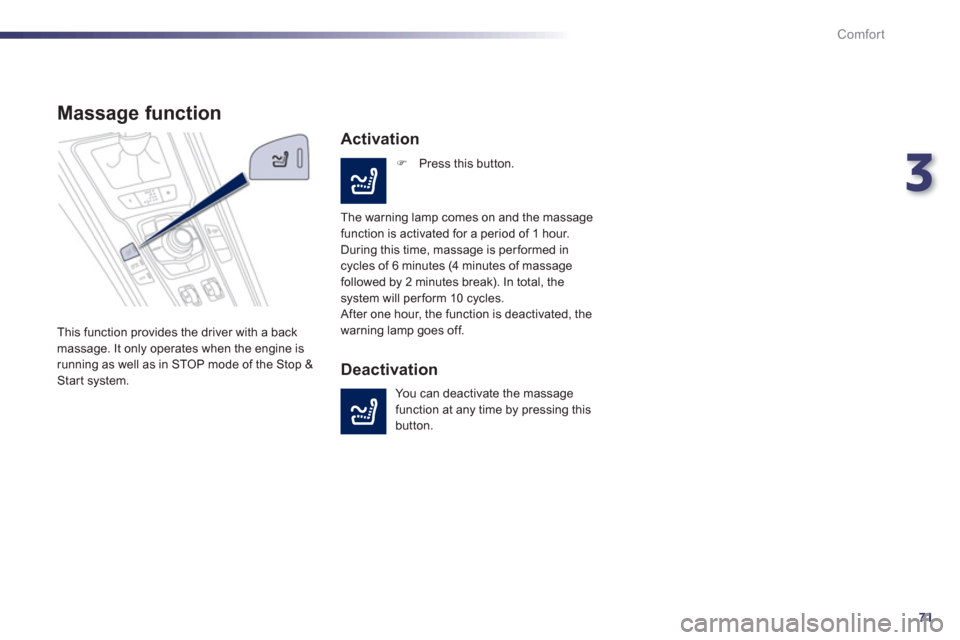
3
71
Comfort
Massage function
This function provides the driver with a back massage. It only operates when the engine is
running as well as in STOP mode of the Stop &Start system.
Activation
F Press this button.
The warning lamp comes on and the massage function is activated for a period of 1 hour. During this time, massage is performed incycles of 6 minutes (4 minutes of massage
followed by 2 minutes break). In total, the
system will per form 10 cycles.
After one hour, the function is deactivated, thewarning lamp goes off.
Deactivation
You can deactivate the massage function at any time by pressing thisbutton.
Page 85 of 340

3
83
Comfort
Warning triangle (stowing)
Before leaving your vehicle to set up and install the triangle, put on your high visibility vest.
The dimensions o
f the triangle (once folded) or its storage box must be:
-
A
: length = 438mm,
-
B: height = 56
mm,
- C: width = 38mm.
Saloon
FPress the lug 1and pull the assembly
towards you.
SW
FTurn the knob 2 to remove the cover.FHold the cover and the triangle so that theydo not fall.
The location for a folded trian
gle is in the inner
trim panel of the boot lid.Placing the triangle in
t
he road
Distance from your vehicle (in metres)
Road
Motorway
DayNight
50 m 80 m
150 m
These are the internationally recognisedvalues.
Use the triangle in line with local driving regulations.
The trian
gle is available as an accessory, contact a PEUGEOT dealer or a qualified
workshop.
F Place the triangle at a distance behindthe vehicle, as shown in the table below,
according to the type of road and the level
of ambient light.
To use the triangle, refer to themanufacturer's instructions.
Page 100 of 340
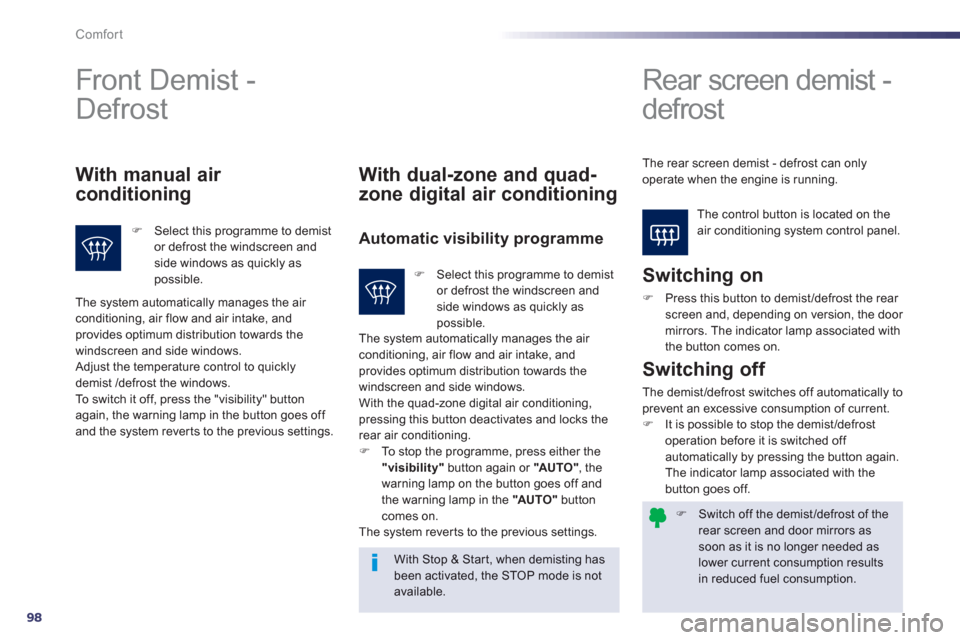
98
Comfort
F Switch off the demist/defrost of the rear screen and door mirrors assoon as it is no longer needed as lower current consumption results in reduced fuel consumption.
Front Demist -
Defrost
Rear screen demist -
defrost
The control button is located on theair conditioning system control panel.
With manual air
conditioning
F Select this programme to demistor defrost the windscreen and side windows as quickly aspossible.
With dual-zone and quad-
zone di
gital air conditioning
Automatic visibility programme
Switching on
F
Press this button to demist/defrost the rear screen and, depending on version, the door mirrors. The indicator lamp associated with
the button comes on.
With Stop & Star t, when demisting has been activated, the STOP mode is not available.
Switching off
The demist/defrost switches off automatically toprevent an excessive consumption of current. F
It is possible to stop the demist/defrost
operation before it is switched off automatically by pressing the button again.
The indicator lamp associated with the
button
goes off.
The system automatically manages the air conditioning, air flow and air intake, and provides optimum distribution towards the
windscreen and side windows.
Adjust the temperature control to quickly
demist /defrost the windows.
To switch it off, press the "visibility" button again, the warning lamp in the button goes off
and the system rever ts to the previous settings.
F Select this programme to demist or defrost the windscreen andside windows as quickly as possible.
The system automatically manages the air conditioning, air flow and air intake, and
provides optimum distribution towards the
w
indscreen and side windows.
With the quad-zone digital air conditioning,
pressing this button deactivates and locks the
rear air conditioning. F To stop the programme, press either the "visibility"button again or "AU TO "
, the
warning lamp on the button goes off and
the warning lamp in the "AU TO "buttoncomes on.
The system rever ts to the previous settings.
The rear screen demist - de
frost can onlyoperate when the engine is running.
Page 103 of 340
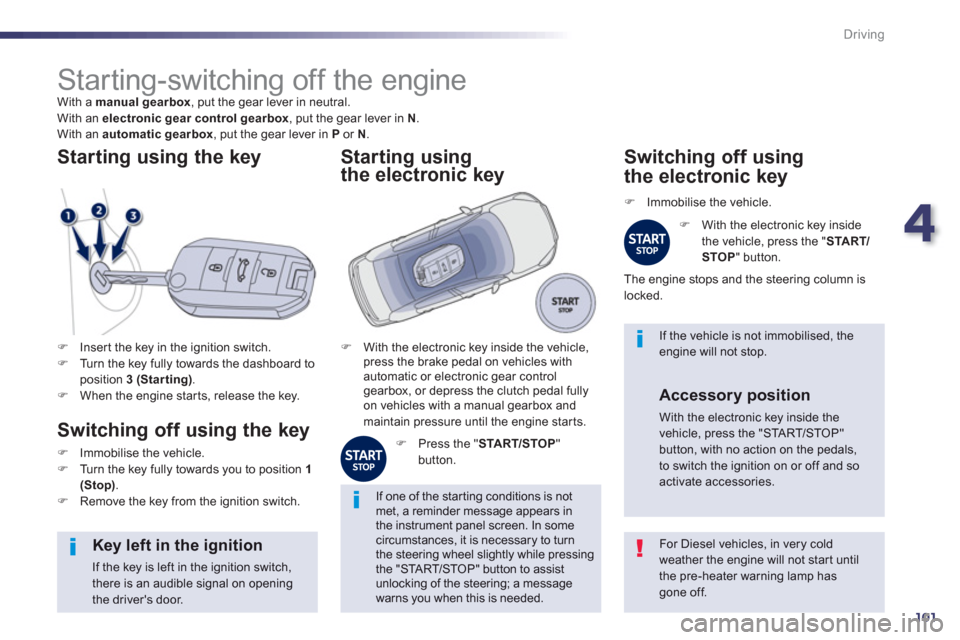
4
101
Driving
Starting-switching off the engine
With a manual gearbox
, put the gear lever in neutral.
With an electronic gear control gearbox, put the gear lever in N.
With an automatic gearbox
, put the gear lever in P
or N
.
FInser t the key in the ignition switch. FTurn the key fully towards the dashboard toposition 3 (Starting).FWhen the engine star ts, release the key.
Starting using the key
Switching off using the key
FImmobilise the vehicle. FTurn the key fully towards you to position 1(Stop)
. FRemove the key from the ignition switch.
For Diesel vehicles, in very cold weather the engine will not star t until the pre-heater warning lamp has
gone off.
Key left in the ignition
If the key is left in the ignition switch,there is an audible signal on opening the driver's door.
If one of the star ting conditions is not met, a reminder message appears inthe instrument panel screen. In somecircumstances, it is necessary to turn the steering wheel slightly while pressing the "STA R T/STOP" button to assist unlocking of the steering; a message warns you when this is needed.
If the vehicle is not immobilised, theengine will not stop. FWith the electronic key inside the vehicle,
press the brake pedal on vehicles with
automatic or electronic
gear controlgearbox, or depress the clutch pedal fully
on vehicles with a manual gearbox and
maintain pressure until the engine star ts.
Starting using
the electronic key
ggg
FPress the " STA R T/STOP"button.
Switching off using
the electronic key
F
Immobilise the vehicle.
F
With the electronic key inside
the vehicle, press the "START/
STOP"
button.
The en
gine stops and the steering column islocked.
Accessory position
With the electronic key inside the vehicle, press the "STA R T/STOP"button, with no action on the pedals, to switch the ignition on or off and so activate accessories.
Page 105 of 340
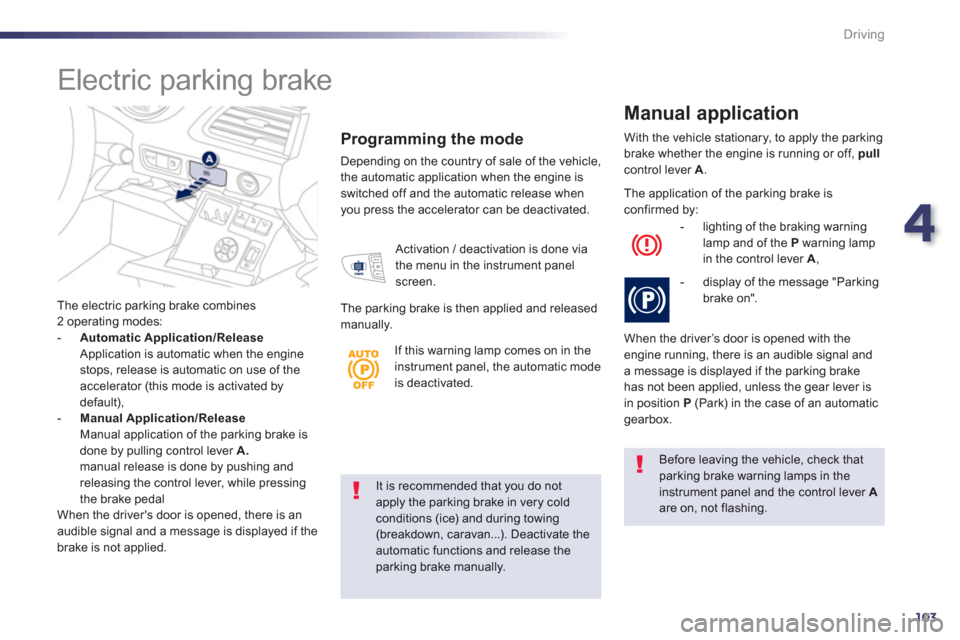
4
103
Driving
It is recommended that you do not apply the parking brake in very cold conditions (ice) and during towing
(breakdown, caravan...). Deactivate theautomatic functions and release theparking brake manually.
Before leaving the vehicle, check that parking brake warning lamps in the instrument panel and the control lever Aare on, not flashing.
The electric parking brake combines
2 operating modes:
-
Automatic Application/Release Application is automatic when the engine stops, release is automatic on use of the accelerator (this mode is activated by
default), -Manual Application/Release Manual application of the parking brake is done by pulling control lever A. manual release is done by pushing and releasing the control lever, while pressing
the brake pedal
When the driver's door is opened, there is an
audible si
gnal and a message is displayed if the
brake is not applied.
Programming the mode
Depending on the country of sale of the vehicle,
the automatic application when the engine is switched off and the automatic release whenyou press the accelerator can be deactivated. With the vehicle stationary, to apply the parking
brake whether the en
gine is running or off, pull
control lever A
.
Manual application
Activation / deactivation is done via
the menu in the instrument panel
screen.
The parkin
g brake is then applied and released
manually. The application o
f the parking brake isconfirmed by:
- li
ghting of the braking warning lamp and of the Pwarning lamp
in the control lever A,
- displa
y of the message "Parking brake on".
When the driver’s door is opened with the
engine running, there is an audible signal and
a message is displayed if the parking brake
has not been applied, unless the gear lever is in position P(Park) in the case of an automatic gearbox.
Electric parking brake
If this warning lamp comes on in the instrument panel, the automatic modeis deactivated.
Page 106 of 340
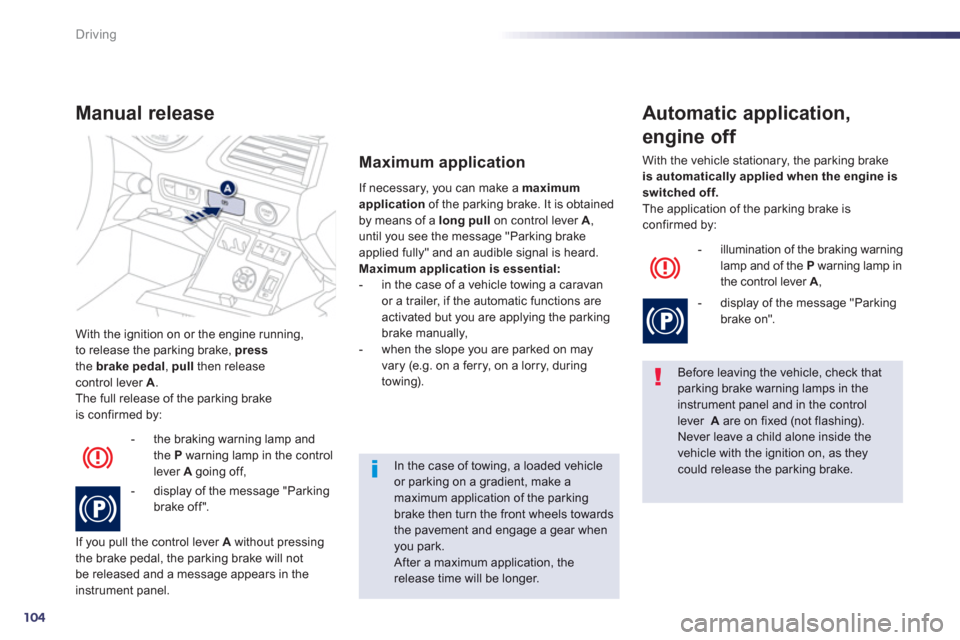
104
Driving
With the ignition on or the engine running,
to release the parking brake, pressthe brakepedal
, pullthen releasecontrol lever A
.
The full release of the parking brake
is confirmed by:
Manual release
- the braking warning lamp and
the P warning lamp in the controllever A
going off,
- displa
y of the message "Parking brake off".
I
f you pull the control lever Awithout pressing
the brake pedal, the parking brake will not
be released and a message appears in the
instrument panel. If necessar
y, you can make a maximum
applicationof the parking brake. It is obtained by means of a long pullon control lever A,
until you see the message "Parking brake
applied fully" and an audible signal is heard.Maximum application is essential:
- in the case of a vehicle towing a caravanor a trailer, if the automatic functions are
activated but you are applying the parkingbrake manually,
- when the slope you are parked on mayvary (e.g. on a ferry, on a lorry, during
towing).
Maximum application
Before leaving the vehicle, check that parking brake warning lamps in the instrument panel and in the control lever A
are on fixed (not flashing).
Never leave a child alone inside thevehicle with the ignition on, as they could release the parking brake.
Automatic application,
engine off
- illumination of the braking warning
lamp and of the Pwarning lamp in
the control lever A ,
- displa
y of the message "Parkingbrake on".
With the vehicle stationary, the parking brake is automatically applied when the engine is
switched off. The application of the parking brake is confirmed by:
In the case of towing, a loaded vehicleor parking on a gradient, make amaximum application of the parkingbrake then turn the front wheels towards the pavement and engage a gear whenyou park.
After a maximum application, the release time will be longer.
Page 107 of 340
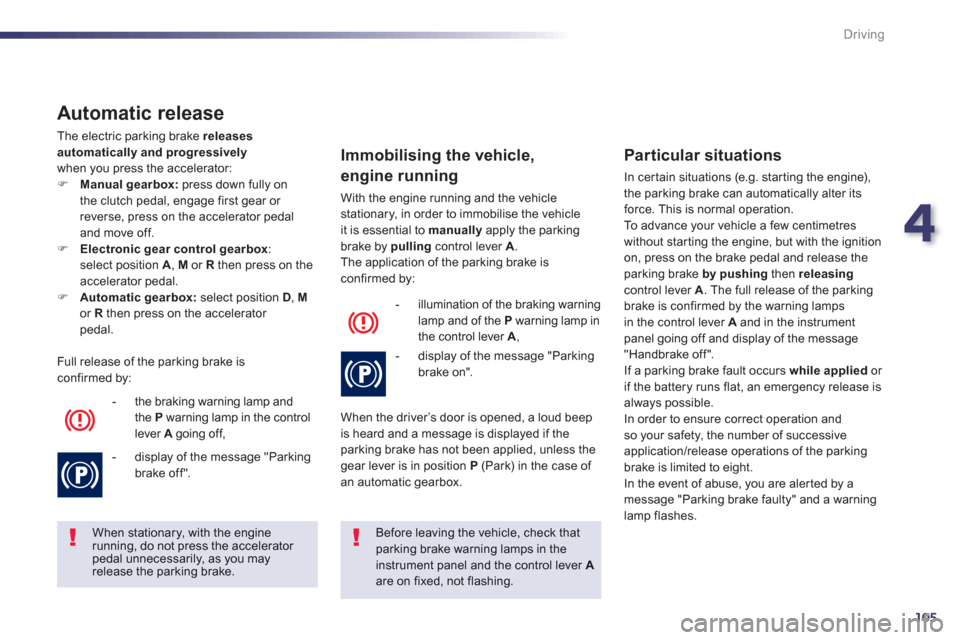
4
105
Driving
Automatic release
The electric parking brake releases automatically and progressively
when you press the accelerator:FManual gearbox:
press down fully on
the clutch pedal, engage first gear or reverse, press on the accelerator pedaland move off.FElectronic gear control gearbox : select position A
, M
or Rthen press on theaccelerator pedal. F Automatic gearbox:select position D , Mor Rthen press on the accelerator pedal.
Full release o
f the parking brake is confirmed by:
- the braking warning lamp and
th
e P warning lamp in the control
lever Agoing off, A
- display of the message "Parking brake off".
When stationary, with the engine running, do not press the accelerator pedal unnecessarily, as you may release the parking brake.
Before leaving the vehicle, check thatparking brake warning lamps in theinstrument panel and the control lever Aare on fixed, not flashing.
Immobilising the vehicle,
engine running
With the engine running and the vehicle
stationary, in order to immobilise the vehicle it is essential to manually
apply the parking
brake by pulling
control lever A.
The application of the parking brake is confirmed by:
- illumination o
f the braking warning
lamp and of the Pwarning lamp in
the control lever A ,
- displa
y of the message "Parkingbrake on".
When the driver’s door is opened, a loud beep
is heard and a message is displayed if theparking brake has not been applied, unless thegear lever is in position P (Park) in the case of an automatic gearbox.
Particular situations
In cer tain situations (e.g. star ting the engine),
the parking brake can automatically alter itsforce. This is normal operation.
To advance your vehicle a few centimetres
without star ting the engine, but with the ignition on, press on the brake pedal and release the
parking brake by pushing then releasingcontrol lever A
. The full release of the parking
brake is confirmed by the warning lamps in the control lever Aand in the instrument
panel going off and display of the message
"Handbrake off".
If a parking brake fault occurs while appliedor
if the battery runs flat, an emergency release is
always possible.
In order to ensure correct operation and
so your safety, the number of successive
application/release operations of the parking brake is limited to eight.
In the event of abuse, you are aler ted by a
message "Parking brake faulty" and a warning
lamp flashes.